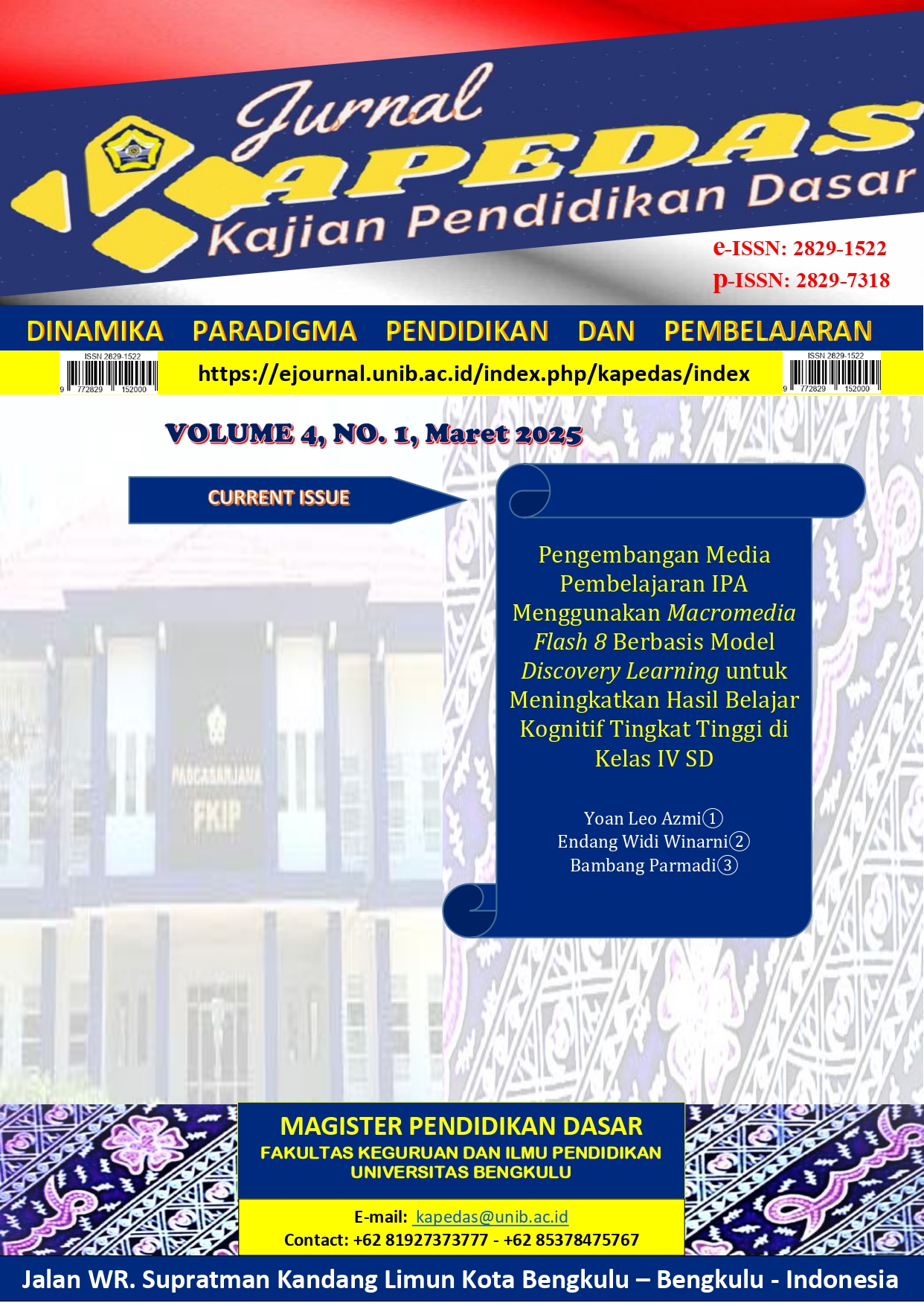Main Article Content
Abstract
This research aims to describe the content elements, cognitive processes and context of AKM questions in madrasa assessments for class VI Indonesian language subjects for the 2021/2022 and 2022/2023 MIS Nurul Huda Bengkulu City academic years. This type of research is mixed methods research. The subjects of this research were class VI students of MIS Nurul Huda, Bengkulu City. The objects in this research are content elements, cognitive processes, and the context of reading literacy, student responses to items in the madrasa assessment for Indonesian language The research instrument is a document in the form of a sheet of analysis results of content elements, cognitive processes and the context of reading literacy. content, cognitive processes, and reading literacy contexts are analyzed and calculated according to the rater's agreement. The results of the research show that: (1) The highest content element for the 2021/2022 AKM questions is information text with 22 questions and the highest content element for AKM 2022/2023 questions is information text with 28 questions; (2) The highest cognitive process element for the 2021/2022 AKM questions is finding information on 28 questions and the highest cognitive process element for the 2022/2023 AKM questions is finding information on 27 questions; (3) The highest context element for the 2021/2022 AKM questions is personal with 22 questions and the highest context element for the 2022/2023 AKM questions is scientific with 15 questions.
Article Details
Copyright (c) 2025 Ahmad Mustofa, Abdul Muktadir, Endang Widi Winarni

This work is licensed under a Creative Commons Attribution-ShareAlike 4.0 International License.

Karya ini dilisensikan di bawah Creative Commons Attribution-ShareAlike 4.0 International License .
References
-
Akbar, S,. (2013). Instrumen Perangkat Pembelajaran. Bandung: PT. Remaja Rosdakarya.
Creswell, J. W. (2017). Research Design: Pendekatan Metode Kualitatif, Kuantitatif, dan Campuran. Yogyakarta: Pustaka Pelajar.
Depdiknas. (2008). Panduan Analisis Butir Soal. Jakarta: Departemen Pendidikan Nasional.
Grigg, W. S., Daane, M. C., Jin, Y., & Campbell, J. R. (2003). The nation’s report card: Reading 2002. Washington, DC: Institute of Education Sciences, U.S. Department of Education
Haryono. (2019). Pembelajaran IPA Abad 21. Yogyakarta: Kepel Press.
Mohajan, H. K. (2017). Two Criteria for Good Measurements in Research: Validity and Reliability. Annals of Spiru Haret University, 17(3): 58-82.
Pusmendik. (2021). Framework Asesmen Kompetensi Minimum (AKM). Jakarta: Pusat Asesmen dan Pembelajaran, Badan Penelitian, Pengembangan dan Perbukuan, Kementerian Pendidikan dan Kebudayaan.
Pusmenjar. (2020). AKM dan Implikasinya pada Pembelajaran. Jakarta: Pusat Asesmen dan Pembelajaran, Badan Penelitian, Pengembangan dan Perbukuan, Kementerian Pendidikan dan Kebudayaan.
Robson, C. (2011). Real World Research: A Resource for Users of Social Research Methods in Applied Settings, (2nd Ed.). Sussex, A. John Wiley and Sons Ltd.
Winarni, E. W. (2021). Teori dan Praktik Penelitian Kuantitatif Kualitatif Penelitian Tindakan Kelas (PTK) Reseach And Development (R&D). Jakarta: Bumi Aksara.
Yopp, R. H., & Yopp, H. K. (2012). Young Children’s Limited And Narrow Exposure To Informational Text. The Reading Teacher, 65(7), 480–490.
References
Creswell, J. W. (2017). Research Design: Pendekatan Metode Kualitatif, Kuantitatif, dan Campuran. Yogyakarta: Pustaka Pelajar.
Depdiknas. (2008). Panduan Analisis Butir Soal. Jakarta: Departemen Pendidikan Nasional.
Grigg, W. S., Daane, M. C., Jin, Y., & Campbell, J. R. (2003). The nation’s report card: Reading 2002. Washington, DC: Institute of Education Sciences, U.S. Department of Education
Haryono. (2019). Pembelajaran IPA Abad 21. Yogyakarta: Kepel Press.
Mohajan, H. K. (2017). Two Criteria for Good Measurements in Research: Validity and Reliability. Annals of Spiru Haret University, 17(3): 58-82.
Pusmendik. (2021). Framework Asesmen Kompetensi Minimum (AKM). Jakarta: Pusat Asesmen dan Pembelajaran, Badan Penelitian, Pengembangan dan Perbukuan, Kementerian Pendidikan dan Kebudayaan.
Pusmenjar. (2020). AKM dan Implikasinya pada Pembelajaran. Jakarta: Pusat Asesmen dan Pembelajaran, Badan Penelitian, Pengembangan dan Perbukuan, Kementerian Pendidikan dan Kebudayaan.
Robson, C. (2011). Real World Research: A Resource for Users of Social Research Methods in Applied Settings, (2nd Ed.). Sussex, A. John Wiley and Sons Ltd.
Winarni, E. W. (2021). Teori dan Praktik Penelitian Kuantitatif Kualitatif Penelitian Tindakan Kelas (PTK) Reseach And Development (R&D). Jakarta: Bumi Aksara.
Yopp, R. H., & Yopp, H. K. (2012). Young Children’s Limited And Narrow Exposure To Informational Text. The Reading Teacher, 65(7), 480–490.
